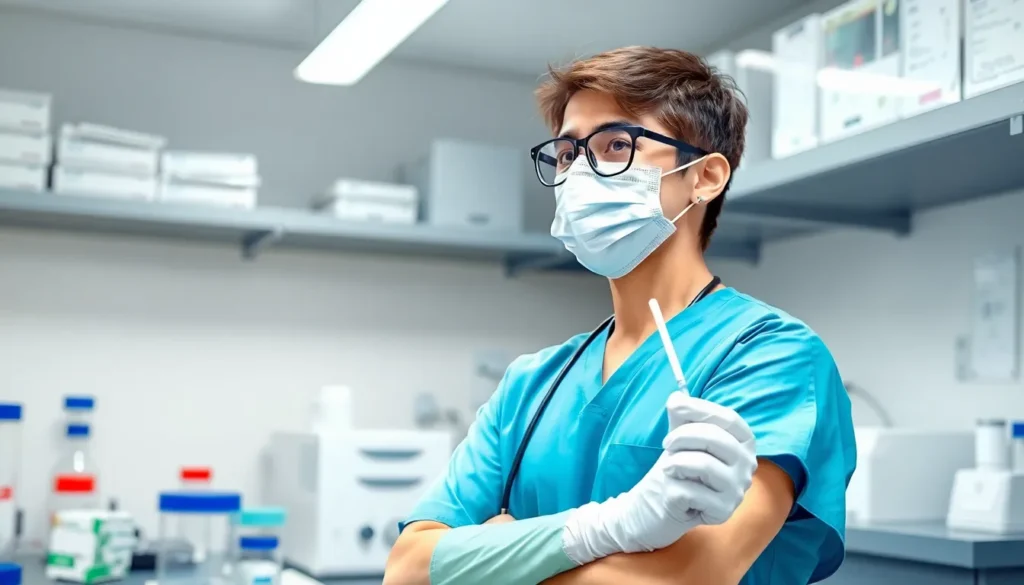In a world where germs seem to have a mind of their own, the viral culture swab emerges as the unsung hero in the battle against invisible foes. Picture this: a tiny cotton swab wielding the power to capture and identify viruses lurking in the shadows. It’s like a detective in a lab coat, ready to solve the mystery of illness one swab at a time.
Table of Contents
ToggleWhat Is a Viral Culture Swab?
A viral culture swab serves a vital role in identifying viruses in clinical specimens. It helps healthcare professionals detect infections, contributing to accurate diagnoses and treatment plans.
Definition and Purpose
A viral culture swab is a sterile tool, often made of synthetic fibers, used for collecting biological samples like nasal secretions or throat swabs. Its primary purpose lies in isolating viruses from specimens, allowing for laboratory analysis. Medical professionals utilize these swabs to detect specific viral infections, such as influenza or SARS-CoV-2. By identifying the virus, clinicians can tailor treatment options effectively. Rapid identification of pathogens can also guide public health measures, ultimately preventing further outbreaks.
How It Works
A viral culture swab collects samples through gentle abrasion of mucosal surfaces. After collection, healthcare providers send these samples to a laboratory for viral culture. In the lab, technicians place the swab into a nutrient-rich medium, supporting viral growth. Specialized equipment then incubates the samples, allowing any viruses present to multiply. Following this growth phase, tests confirm the virus’s presence through techniques like polymerase chain reaction (PCR) or antibody detection. This systematic process yields critical information, assisting in the diagnosis and treatment of viral infections.
Types of Viral Culture Swabs

Several types of viral culture swabs exist, each designed for specific sampling procedures. Each type offers unique advantages in collecting biological samples for viral detection.
Nasopharyngeal Swabs
Nasopharyngeal swabs collect samples from the upper respiratory tract. A flexible shaft and a soft tip ensure gentle collection, minimizing discomfort. Inserted through the nostril, this swab reaches the nasopharynx, a key area for viral detection. Healthcare professionals often use nasopharyngeal swabs to identify respiratory viruses like influenza and SARS-CoV-2. Their efficacy lies in the ability to obtain a rich specimen, leading to more accurate laboratory analysis.
Oropharyngeal Swabs
Oropharyngeal swabs target the back of the throat. This type of swab is particularly effective in detecting pathogens responsible for throat infections. A soft tip aids in proper sample collection without causing irritation. When using oropharyngeal swabs, clinicians gather samples from the tonsillar region and posterior pharyngeal wall. These samples are vital for identifying viruses such as Group A Streptococcus and various respiratory viruses.
Other Types
Other types of viral culture swabs include vaginal, rectal, and eye swabs. Specimens from these anatomical sites are essential for detecting sexually transmitted infections, enteric viruses, or conjunctivitis. Each swab type varies in design to accommodate specific areas, ensuring thorough and effective sample collection. Healthcare providers select the appropriate swab based on the suspected infection, facilitating targeted treatment strategies. These diverse options enhance the accuracy of viral detection, supporting effective public health interventions.
Uses of Viral Culture Swabs
Viral culture swabs play a pivotal role in medical diagnostics and treatment monitoring. Their application ranges from diagnosing viral infections to evaluating treatment effectiveness.
Diagnosing Viral Infections
Diagnosing viral infections relies heavily on the accurate collection of samples. Viral culture swabs collect specimens from various anatomical areas, such as the nasopharynx or oropharynx. With samples placed in a nutrient-rich medium, laboratory technicians can watch for viral growth. Techniques like polymerase chain reaction (PCR) confirm the virus’s presence, allowing healthcare professionals to identify infections like influenza or SARS-CoV-2. Swift and precise identification significantly enhances patient care and enables timely public health responses.
Monitoring Treatment Efficacy
Monitoring treatment efficacy involves tracking a patient’s viral load over time. After initiating antiviral therapy, medical professionals utilize viral culture swabs to assess how effectively the treatment works. Regular sampling helps determine whether the virus is being suppressed or if adjustments to therapy are necessary. This ongoing assessment aids in tailoring treatment plans, ensuring optimal outcomes for patients. Accurate monitoring also contributes to broader public health strategies aimed at controlling infections within communities.
Advantages and Limitations
Viral culture swabs hold significant importance in diagnostics and treatment monitoring. Benefits exist alongside potential limitations, each affecting their application in healthcare settings.
Benefits of Using Viral Culture Swabs
Viral culture swabs offer various advantages for virus detection. Accurate sample collection allows healthcare professionals to identify infections early. Rapid diagnosis supports timely treatment decisions, which can improve patient outcomes significantly. Another benefit involves the ability to monitor viral loads effectively; this helps determine the impact of antiviral therapies. Additionally, using specialized swabs for different anatomical sites enhances the specificity of testing, making it easier to pinpoint the offending virus. With these qualities, viral culture swabs are invaluable tools in managing viral infections.
Potential Limitations and Challenges
Despite their advantages, viral culture swabs face certain limitations. Sample degradation can occur if the collection process is not handled correctly, potentially leading to false negatives. Incubation times may vary, delaying results and slowing down timely patient care. Furthermore, not all viruses grow well in culture, which can limit the detection scope for some infections. Challenges with cross-contamination also exist, where samples can become contaminated, affecting test accuracy. Understanding these limitations helps healthcare providers optimize the use of viral culture swabs in practice.
Viral culture swabs play an indispensable role in modern medicine by enhancing the accuracy of viral detection and diagnosis. Their ability to collect samples from various anatomical sites allows healthcare professionals to tailor treatment strategies effectively. While they offer significant advantages in early infection identification and monitoring, it’s essential to remain aware of their limitations. By understanding both the strengths and weaknesses of viral culture swabs, healthcare providers can optimize their use, ultimately improving patient outcomes and supporting public health initiatives. As technology advances, the continued evolution of these tools will further enhance their effectiveness in combating viral infections.





